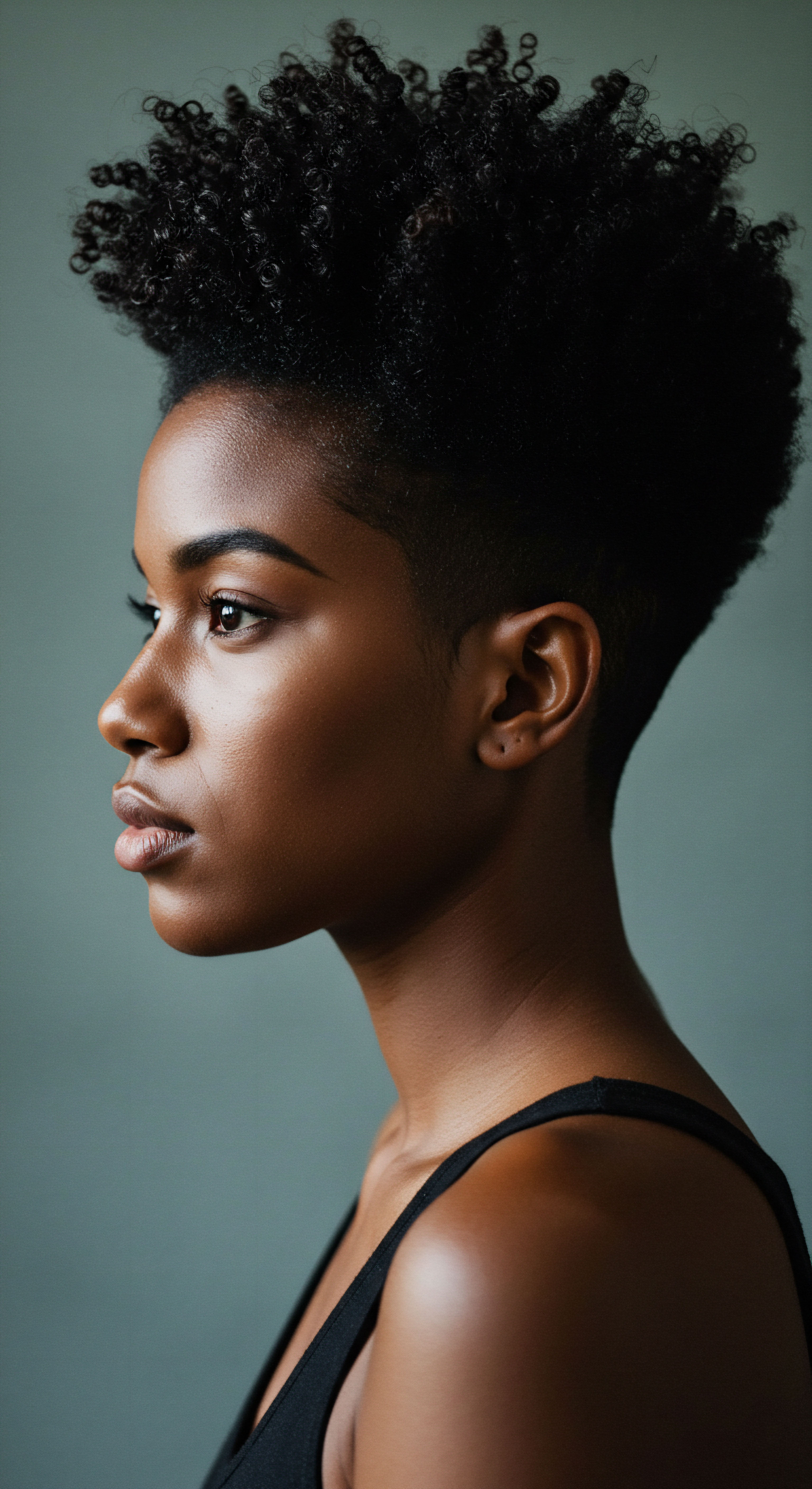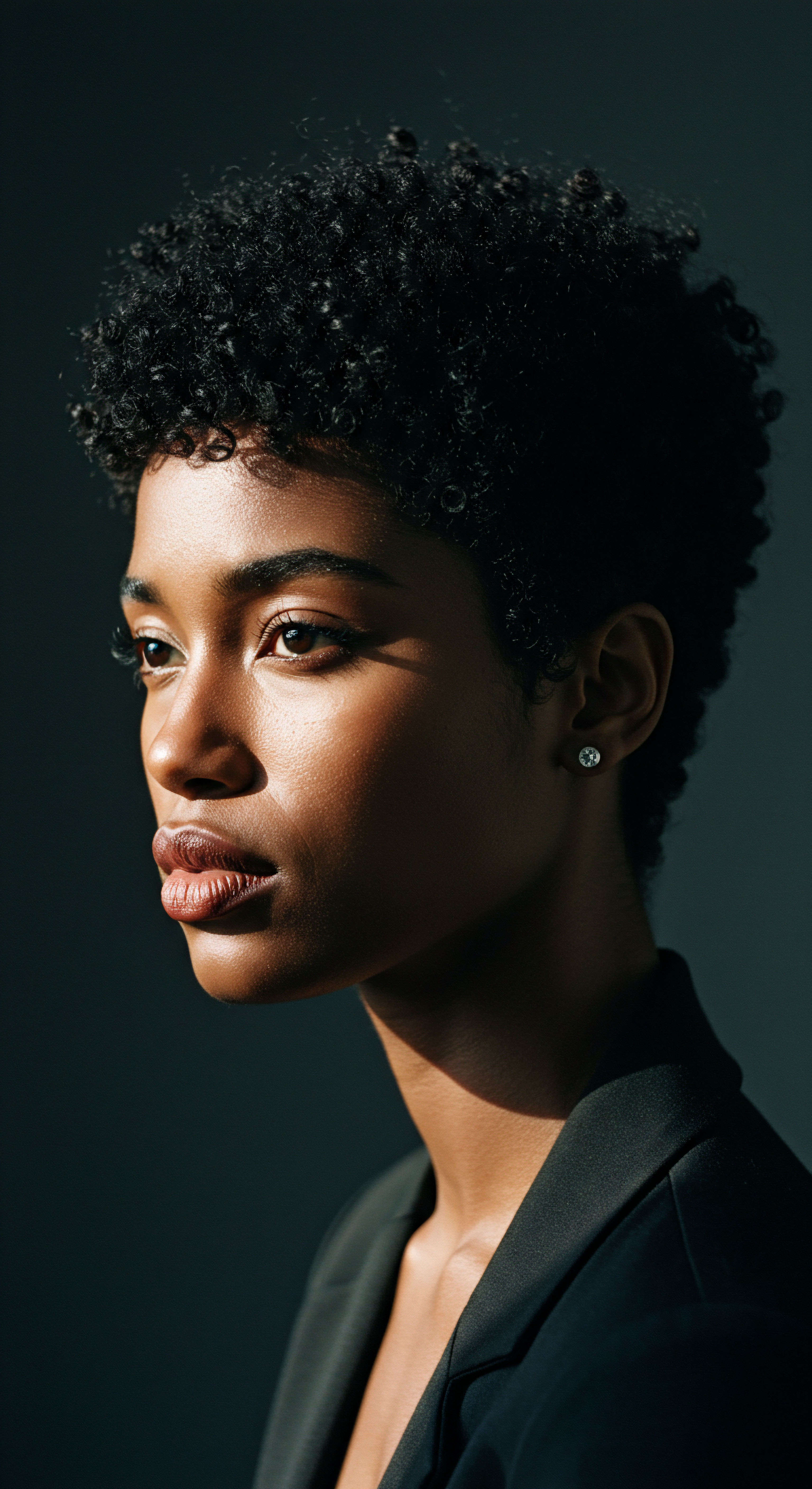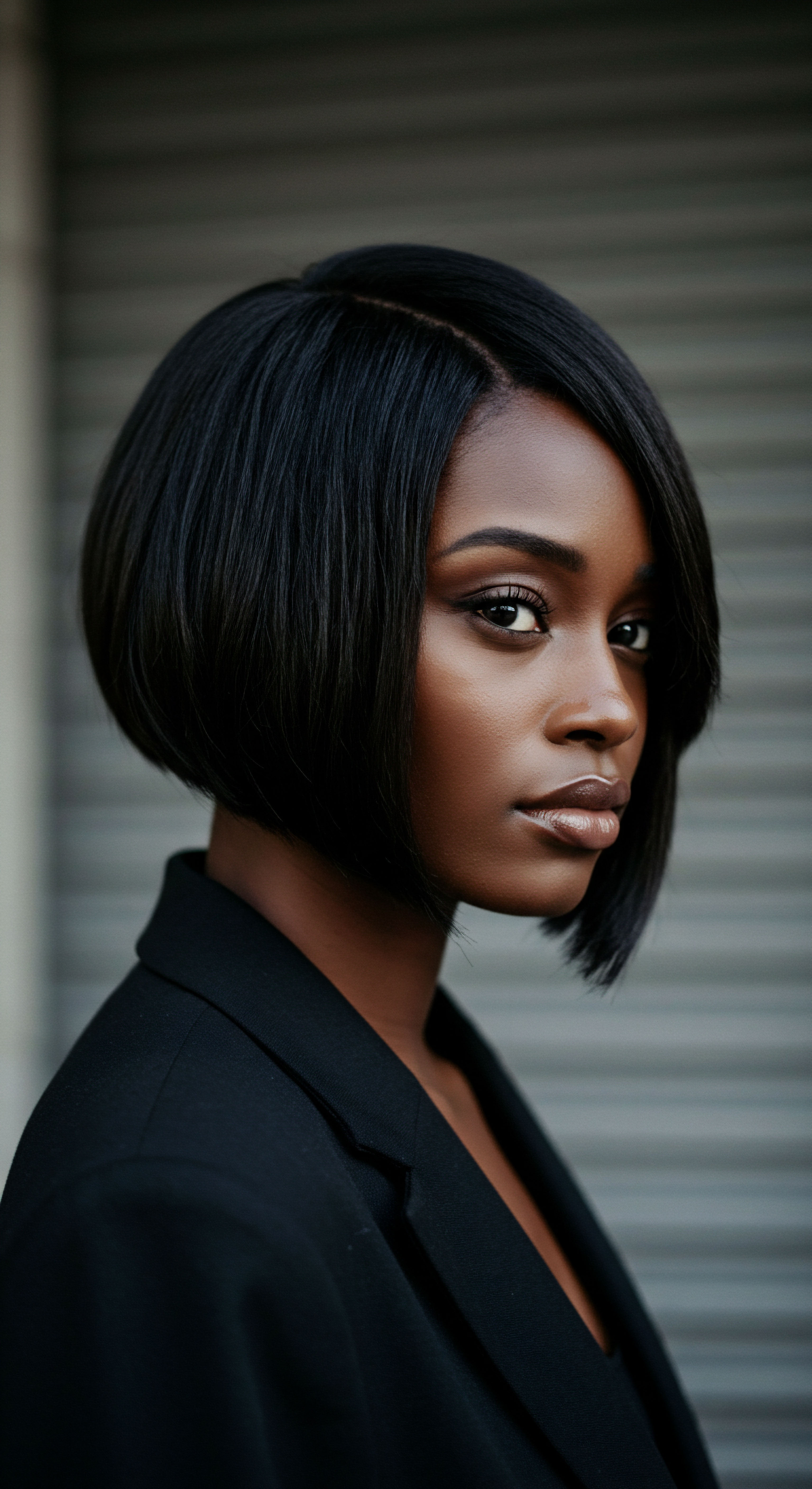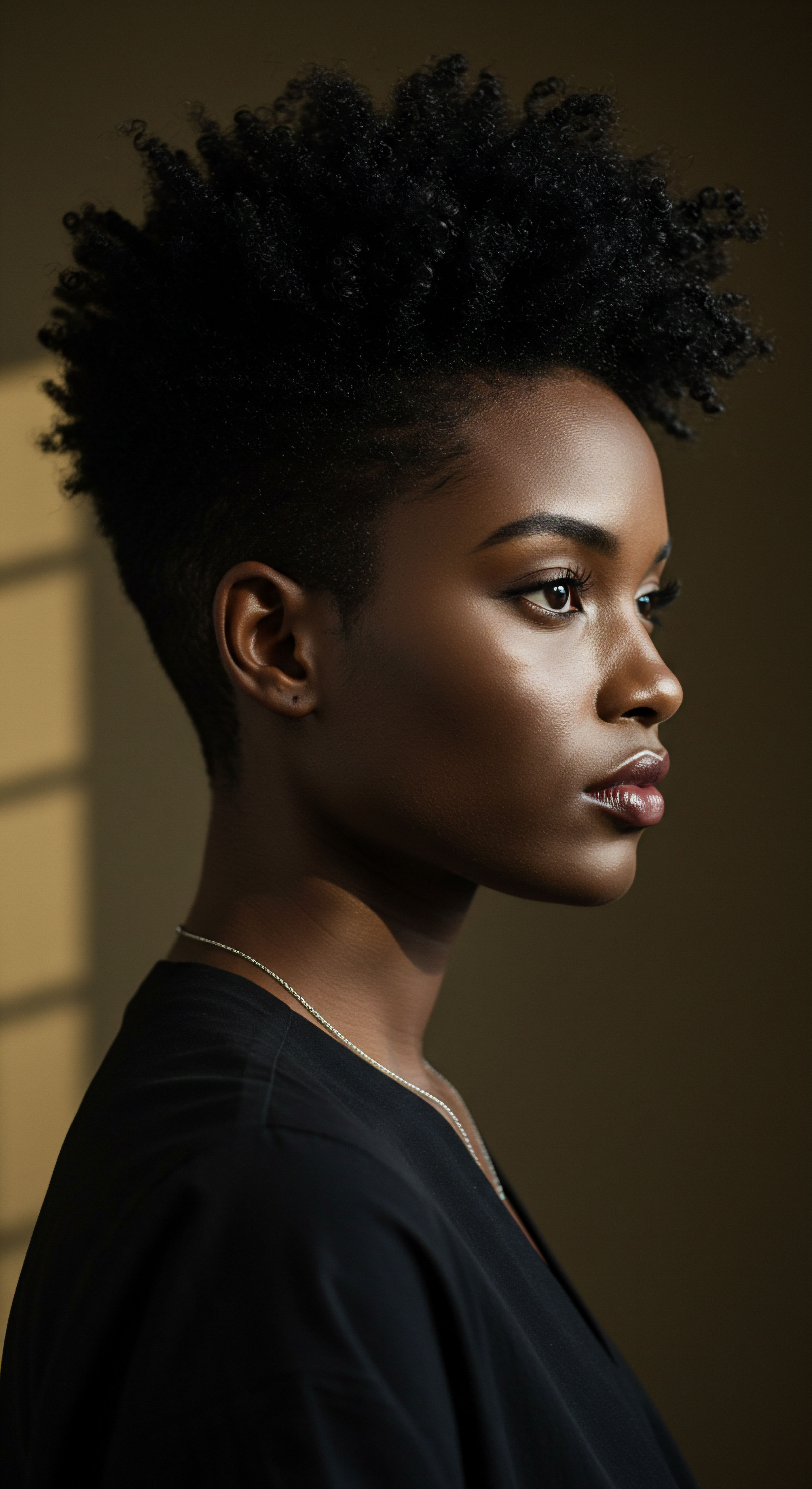
Roots
The coiled strands that crown so many heads carry stories, echoes of sun-drenched lands and ancestral wisdom. For generations uncounted, before laboratories synthesized compounds and shelves brimmed with bottles, people turned to the earth itself for hair’s well-being. This journey into historical natural ingredients for coiled hair health is a quiet invitation, a gentle beckoning to rediscover the elemental understanding woven into ancient practices. We seek not just ingredients, but the profound connection between human hands, nature’s bounty, and the deeply personal act of caring for one’s hair.
From the earliest recorded moments of human adornment, hair has held a significant place, a canvas for identity and expression. The search for substances to cleanse, soften, and strengthen these unique textures led diverse cultures to a surprising array of plant-based remedies and mineral wonders. Their knowledge, passed down through oral traditions and daily rituals, formed the bedrock of hair wellness.

Ancient Botanical Helpers
Across continents, indigenous populations recognized specific plants for their remarkable properties in tending to coiled hair. These botanical helpers were not merely functional; they were often regarded with reverence, their growth tied to the rhythm of seasons and the health of the land.
- Oils ❉ Plant oils served as cornerstones for moisturizing and protecting coiled strands. Olive oil, cherished in ancient Mediterranean cultures, was applied for nourishment and to improve hair elasticity. Coconut oil, deeply rooted in ancient Ayurvedic practices, offered profound moisturization, preventing protein loss. In African traditions, shea butter and marula oil provided deep conditioning and moisture retention. These oils, rich in fatty acids and antioxidants, coated the hair shaft, reducing friction and aiding in detangling.
- Clays ❉ Mineral-rich clays, such as rhassoul clay from North Africa, were widely used for cleansing without stripping natural oils. These clays absorb impurities and product buildup, leaving hair feeling refreshed and clean. Bentonite clay, found globally, also served as a traditional hair cleanser in various regions, including Iran. The Himba tribe in Namibia famously blended clay with butterfat and ochre to style and protect their hair from environmental elements.
- Plant Saponins ❉ Nature’s own cleansers came in the form of saponin-rich plants. Soapberries (Sapindus) and shikakai (Acacia concinna) from India were boiled to create a gentle lather for washing hair. These natural surfactants cleanse without harshness, maintaining the hair’s natural moisture. Yucca root, used by Native American tribes, provided a similar soapy lather for cleansing.
Historical hair care, particularly for coiled textures, was deeply rooted in the intelligent use of local botanicals and minerals, recognizing their inherent properties for cleansing, conditioning, and protection.

Geographical Footprints of Hair Care
The specific ingredients utilized often reflected the local flora, creating unique regional approaches to coiled hair wellness. This geographical footprint highlights human adaptability and the ingenious ways communities utilized their immediate surroundings.
In the Amazon rainforest, indigenous communities relied on oils from trees like babassu, acai, cupuaçu, and pataua for hair care. These oils are known for their hydrating and strengthening properties, reflecting the lush, biodiverse environment from which they hail. The tradition of using such oils is a testament to generations of observation and experimentation within these ecosystems.
African societies, with their diverse landscapes, contributed ingredients like baobab oil, known for its vitamins and omega fatty acids, which moisturize dry, brittle hair and strengthen weak strands. African black soap, derived from the ash of local vegetation such as cocoa pods and plantain skins, provided a nutrient-rich cleansing agent.
Asian cultures, particularly in India, refined the use of herbs like amla (Indian gooseberry), hibiscus, and neem. These ingredients, central to Ayurvedic practices, were used not only for cleansing but also for scalp health, reducing breakage, and promoting growth. The historical depth of these practices speaks to a continuous lineage of hair care wisdom.
| Region North Africa |
| Primary Ingredients Rhassoul Clay, Argan Oil |
| Noted Benefits for Coiled Hair Cleansing without stripping, moisture, shine |
| Region India |
| Primary Ingredients Coconut Oil, Amla, Shikakai, Neem |
| Noted Benefits for Coiled Hair Deep moisturization, strengthening, cleansing, scalp health |
| Region Amazonia |
| Primary Ingredients Babassu Oil, Acai Oil, Pataua Oil |
| Noted Benefits for Coiled Hair Hydration, strengthening, anti-aging, scalp nourishment |
| Region West Africa |
| Primary Ingredients Shea Butter, African Black Soap |
| Noted Benefits for Coiled Hair Moisturizing, protection, gentle cleansing |
| Region Native Americas |
| Primary Ingredients Yucca Root, Aloe Vera |
| Noted Benefits for Coiled Hair Natural cleansing, conditioning, scalp soothing |
| Region This table illustrates the diverse, geographically specific natural resources used historically for hair care. |

Ritual
Stepping from the foundational understanding of ingredients, we arrive at the practical heart of historical hair care ❉ the rituals themselves. These were not simply acts of hygiene; they were often meditative, communal, and deeply ingrained practices that honored the body and its connection to the natural world. Our contemporary search for effective methods for coiled hair often circles back to these ancient ways, seeking their quiet wisdom and the gentle guidance they offer. This section explores how natural ingredients transformed into meaningful routines, reflecting a profound respect for hair’s texture and needs.
The application of these natural substances was often systematic, a deliberate process refined over generations. It speaks to an intimate acquaintance with hair, understanding its rhythms and responses to various preparations. The care extended beyond mere superficial treatment, aiming for genuine wellness of the scalp and strands.

How Were Cleansers Prepared and Applied?
The concept of “shampoo” as we know it today is a relatively modern invention. Historically, cleansing agents were prepared from plants, often involving simple yet effective methods that respected the hair’s delicate structure.
In India, for example, soapberries (reetha) and shikakai pods were boiled to create a liquid. This liquid, rich in natural saponins, would then be strained and used to gently cleanse the hair. This method allowed for a mild lather that removed impurities without stripping away the hair’s essential oils, a common issue with many contemporary formulations. The cleansing ritual was often followed by other conditioning steps, ensuring the hair remained soft and manageable.
Clays, like rhassoul, were mixed with water to form a paste. This paste was applied to the hair and scalp, allowed to sit, and then rinsed away. The absorbent nature of the clay drew out excess oils and dirt, providing a deep yet gentle clean. Such practices highlight an early understanding of porosity and the need for non-stripping cleansers for textured hair.

The Art of Conditioning and Moisturization
Coiled hair, by its very structure, tends to be drier than straighter hair types because natural scalp oils struggle to travel down the spirals. Ancient traditions addressed this inherent need for moisture with a variety of rich, nourishing applications.
Oils, such as coconut, olive, and shea butter, were frequently warmed and massaged into the scalp and hair. This practice, often termed “oil bathing” in ancient India, stimulated blood flow to the scalp while providing deep conditioning to the strands. The warmth aided absorption, allowing the beneficial fatty acids and vitamins to penetrate the hair shaft more effectively. This was a regular, sometimes daily, act of care, designed to keep hair supple and resilient.
Herbal rinses, concocted from infusions of plants like hibiscus, amla, or rosemary, provided additional conditioning and often targeted specific concerns like shine or scalp health. These rinses were left in or gently rinsed out, leaving behind a subtle botanical layer of protection and nourishment.
Historical hair care rituals were characterized by their gentle cleansing and consistent moisturizing practices, often employing warm oils and herbal infusions to sustain hair’s vitality.

Were There Specific Techniques for Coiled Hair?
While historical texts might not always explicitly detail techniques for “coiled” hair in modern terms, the practices themselves reveal an implicit understanding of textured hair’s unique needs. The focus on moisture retention, gentle detangling, and protective styling aligns remarkably with contemporary recommendations for coiled hair.
For example, the widespread use of oils and butters for detangling and softening indicates a recognition of coiled hair’s propensity for tangles and breakage if not handled with care. Applying these lubricants before combing, or even using fingers for detangling, would have been common.
Protective styles, such as braids and twists, were not just aesthetic choices but also practical methods for preserving hair length and minimizing manipulation. These styles shielded delicate strands from environmental stressors and reduced daily wear and tear, allowing hair to retain moisture and grow without excessive breakage. The longevity of these styles meant less frequent washing and manipulation, further contributing to hair health.
- Warm Oil Massages ❉ Regularly massaging warm oils into the scalp and hair was a common practice across many cultures. This improved circulation, nourished follicles, and softened strands.
- Gentle Detangling ❉ Applying oils or plant-based conditioners to wet or damp hair before detangling with fingers or wide-toothed tools prevented breakage.
- Protective Styles ❉ Braids, twists, and other contained styles shielded hair from the elements and reduced daily manipulation, supporting length retention.
- Clay Masks ❉ Mixing clays with water or herbal infusions to create masks for cleansing and scalp balancing was a recurring theme.

Relay
To truly comprehend the historical support for coiled hair, we must look beyond surface-level descriptions, inviting science, anthropology, and deep cultural insight into our conversation. This inquiry transcends simple ingredient lists, asking how ancient wisdom intersected with observable results, often without the benefit of modern microscopes or chemical analyses. It beckons us to consider the profound interplay of environmental factors, social structures, and inherent biological understanding that shaped historical hair care. How did these time-honored practices, seemingly simple, achieve such remarkable outcomes for textured strands?
The efficacy of many historical natural ingredients for coiled hair was not merely anecdotal; it rested upon a deep, intuitive understanding of plant chemistry and hair biology, long before these fields were formally named. This collective wisdom, passed from one generation to the next, often mirrored scientific principles we now validate in laboratories.

The Science Within Ancient Practices
Many plant-based ingredients used historically possess compounds that modern science now identifies as beneficial for hair. The saponins in soapnuts (reetha) and shikakai, for example, are natural surfactants. They produce a mild lather that cleanses without stripping the hair’s natural oils, a property particularly valuable for moisture-sensitive coiled hair. This gentle cleansing helps maintain the hair’s lipid barrier, reducing dryness and frizz.
Plant oils, like coconut and olive, are rich in fatty acids. Coconut oil’s high lauric acid content allows it to penetrate the hair shaft, reducing protein loss and improving overall hair structure. Olive oil, abundant in monounsaturated fats and antioxidants, nourishes the scalp and strengthens hair. These molecular structures, though unknown to ancient practitioners, dictated the visible benefits they observed.
Consider the historical use of certain clays. Rhassoul clay, for instance, contains minerals like silica, magnesium, calcium, and potassium. These minerals contribute to its absorbent properties, drawing out impurities while providing beneficial elements to the scalp and hair. The very structure of coiled hair, with its raised cuticles, makes it more susceptible to moisture loss; thus, ingredients that cleanse gently and seal moisture were inherently effective.

Fermentation’s Unseen Power for Hair Wellness
A less commonly discussed, yet profoundly impactful, historical practice involves the use of fermented ingredients. While fermented rice water has gained contemporary popularity, its roots stretch back centuries in various Asian cultures, including China, Korea, and Japan, where it was used for both skin and hair. The Red Yao women of China, renowned for their exceptionally long and healthy hair, traditionally fermented rice water for 7-10 days.
This extended fermentation period is a critical element. Modern research validates that fermentation alters the chemical composition of ingredients, often increasing the bioavailability of beneficial compounds. In the case of fermented rice water, this process yields inositol (vitamin B8), which has been shown to repair the hair’s keratin structure. Furthermore, fermentation can produce amino acids that boost hair elasticity by 10-15%, and natural antioxidants that combat environmental damage.
A study highlighted the specific benefits of fermented rice water for hair, noting its ability to naturally lower pH to around 4.5-5.5, which aligns perfectly with the hair cuticle’s optimal pH. This pH balance helps to smooth and close the hair cuticle, which is particularly important for coiled hair, as an open cuticle leads to frizz and vulnerability. Regular rice water, without fermentation, often sits at a higher pH (6-7), potentially leaving cuticles open. This precise biochemical alignment, discovered through generations of trial and observation, offers a compelling example of traditional practices anticipating modern scientific understanding.

Beyond the Botanical ❉ Cultural and Social Dimensions
The support for coiled hair historically extended beyond just ingredients; it was deeply intertwined with cultural identity and social practices. Hair care rituals were often communal events, fostering connections and transmitting knowledge.
In many African societies, hair braiding and styling were sophisticated art forms, passed down through matriarchal lines. These styles, while aesthetically significant, also served protective functions, shielding hair from harsh climates and reducing daily manipulation. The practice of African threading, for instance, used thread to stretch and protect hair, minimizing breakage.
The choice of ingredients also carried cultural weight. The use of specific oils, clays, or plant extracts might have been tied to local spiritual beliefs, rites of passage, or symbols of status and beauty. The emphasis on natural, locally sourced ingredients also points to sustainable practices, where communities lived in harmony with their environment, utilizing what was readily available and renewable.
| Fermented Ingredient Fermented Rice Water |
| Key Compounds Inositol (Vitamin B8), Amino Acids, Antioxidants |
| Impact on Coiled Hair Repairs keratin structure, boosts elasticity, fights environmental damage, pH balancing for cuticle smoothness |
| Fermented Ingredient Fermented Apple Cider Vinegar |
| Key Compounds Acetic Acid, Probiotics |
| Impact on Coiled Hair Balances scalp pH, supports healthy scalp microbiota, removes buildup gently |
| Fermented Ingredient Fermented Plant Extracts (e.g. Aloe, Dandelion) |
| Key Compounds Increased Bioavailability of Vitamins, Enzymes, Peptides |
| Impact on Coiled Hair Enhanced hydration, antioxidant protection, irritation relief, easier absorption by hair and scalp |
| Fermented Ingredient Fermentation transforms natural ingredients, amplifying their benefits for hair health through increased nutrient bioavailability and optimal pH levels. |

What Does Modern Research Say About Ancient Wisdom?
Contemporary scientific inquiry increasingly validates the efficacy of many traditional hair care practices. Research into ethnobotany, the study of how people use plants, continues to uncover the biochemical underpinnings of ancient remedies.
For instance, studies confirm the antimicrobial and anti-inflammatory properties of many herbs traditionally used for scalp conditions, such as neem and rosemary. The ability of certain oils to penetrate the hair shaft and prevent protein loss is also supported by scientific analysis. This growing body of evidence closes the gap between historical observation and modern understanding, revealing that our ancestors were indeed practicing a sophisticated form of applied science.
The move towards “clean beauty” and natural ingredients in contemporary hair care reflects a cyclical return to these time-tested methods. Consumers are seeking alternatives to synthetic compounds, turning back to the very earth-derived substances that supported coiled hair health for millennia. This re-discovery is not merely a trend; it is a recognition of enduring wisdom.

Reflection
As we draw our exploration to a close, the echoes of ancestral whispers about hair care linger, inviting a deeper consideration of our own practices. The historical journey through natural ingredients for coiled hair reveals a legacy not just of substances, but of connection—connection to the earth, to community, and to the self. It speaks to an inherent wisdom, a quiet understanding of what truly nourishes and protects.
Perhaps the enduring message from these ancient traditions is a gentle reminder to slow down, to listen to our hair, and to honor the simplicity and profound efficacy of nature’s offerings. What small, thoughtful steps might we take today to weave this ancient care into our modern lives?

References
- Rinaldi, A. et al. “Rediscovering Historical Hair Care Practices.” Fabulive, 2024.
- Kora, A. J. “Plant saponin biosurfactants used as soap, hair cleanser and detergent in India.” ResearchGate, 2022.
- Nagarajan, S. “Indian Beginnings of the Shampoo.” ScienceIndiamag, 2025.
- Ayanae. “Powerful African and Asian Herbs for Hair Growth ❉ Nature’s Remedies.” AYANAE, 2024.
- “The Legacy of Lathers ❉ Tracing the Historical Use of Natural Ingredients.” Fabulive, 2023.
- “Cosmetopoeia of African Plants in Hair Treatment and Care ❉ Topical Nutrition and the Antidiabetic Connection?” MDPI, 2022.
- “Fermented foods for hair ❉ unexpected insights.” Bebrų Kosmetika, 2025.
- “Role of Fermented Ingredients in Scalp Microbiota Balance.” KERA BOND hair science, 2024.
- “The Rice Renaissance ❉ Why Fermented Rice Water Is Revolutionizing Hair Care.” 2025.
- “Ditch the Shampoo Bottle ❉ 5 Ancient Hair Cleansing Secrets That Actually Work.” 2025.
- “Getting To The Root of Hair Cleansing.” natureofthings, 2023.
- “Traditional African Secrets For Long And Healthy Hair.” Africa Imports, 2021.
- “Ayurveda For Afro Hair.” Root2tip, 2024.
- “The Ultimate Guide to Curly & Wavy Hair Care for Indian Hair.” Olamor, 2023.
- “Curly Hair in History.” Reddit, 2023.
- “Bentonite Clay as a Natural Remedy ❉ A Brief Review.” PMC – PubMed Central, 2017.
- “Ancient African Hair Growth Secrets For Healthy Hair.” Sellox Blog, 2021.
- “From Ancient Rituals to Modern Marvels ❉ A Journey through the History of Hair Washing, Shampoo, and Conditioner.” Realizations with Tiffany K. Charles, 2023.
- “Hair Care Secrets of the Past ❉ What Our Ancestors Used for Healthy Hair.” 2024.
- “Revisiting Amazonian Plants for Skin Care and Disease.” MDPI, 2020.
- “Benefits of Botanical Oils From The Amazon Based On Research.” 2024.
- “Unlocking Saponins ❉ Nature’s Gift for Beautiful Skin.” Clinikally, 2023.
- “Ethnobotany and Conservation Status of Saponin Rich Plants of Gangetic Plain Having Both Medicinal and Cleansing Properties.” ResearchGate, 2013.
- “What did people use back then before hair mousse, clay, and gel were invented?” Quora, 2020.
- “Cosmetics and Personal Care Products in the Medicine and Science Collections Hair Care.” Smithsonian Institution.
- “A guide to curl care the South Indian way.” Cosmopolitan India, 2024.
- “The Ancient Natural Ways of Hair Care Across Continents.” 22 Ayur, 2023.
- “Why Fermented Ingredients Boost Organic Skincare & Haircare.” Learn Canyon, 2024.
- “Clays in Cosmetics and Personal-Care Products.” Cambridge Core, 2024.
- “What Did People Use Before Shampoo?” Scandinavian Biolabs, 2025.
- “Golden Locks ❉ Hair Care in the Renaissance Era.” Living History, 2024.
- “Soaps.” USDA Forest Service.